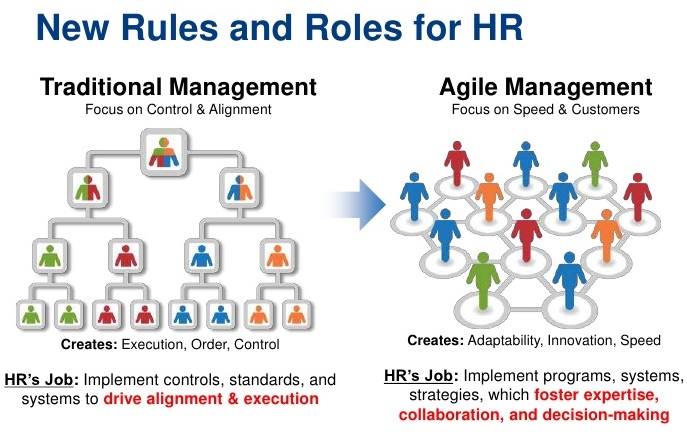Applying Agile Practices - Agile Human Resources (HR)
Human Resources (HR) also manages complex projects and serves multiple stakeholders, often times with competing priorities that require consistent, effective strategies in their approach to communication, programs, administration, and talent management. Since 2012, “Agile HR” (Deloitte) has emerged as a popular discipline with the goal of empowering HR professionals to better “manage volatility, enhance adaptability, and strengthen the organization by applying Agile methodologies to their talent-management processes.”
According to the HR Trend Institute, “Agile HR” refers to:
- a way of working and organizing of the HR function that facilitates responsiveness and adaptiveness of activities and structures,
- facilitating the flexibility in matching workforce fluctuations to demand, and
- the way the HR function supports the organization in becoming more responsive and adaptive.
With Agile HR, the traditional focus on control and alignment has shifted to a more Agile focus on speed of responsiveness and customers.

Source: Agile HR presentation by Leigh Ann Shaffner
Human Resources is no longer limited to just implementing controls and standards to drive execution, but rather to facilitate programs and strategies that improve organizational agility, innovation, collaboration, and enhance decision-making. HRSG provides a few examples of how traditional approaches to HR must shift when using an Agile approach:
| Traditional Approach | Agile HR Approach |
|---|---|
| Underperforming employee in a current role, or needs to prepare for a new role, is assigned training to achieve a specific performance level. | Employees are given a myriad of opportunities to learn and stretch themselves independent of a specific, job-related goal. |
| As jobs become available, the search for candidates begins. Once the best candidate is identified, the talent acquisition process is complete. | Organizations invest in their employer brand and cultivate ongoing relationships with talent across multiple channels, including social. |
| Talent management is owned by HR, and the process by which talent is acquired, evaluated, and developed are proprietary and inaccessible. | Talent management is facilitated by HR, which empowers employees to take ownership of their own development. Employees understand and are active participants in talent acquisition, evaluation, and development processes. |
| Jobs are discrete elements in a complex system. Job requirements are related to specific workplace tasks. | All jobs directly support the mission and values of the organization, and all employees understand how their on-the-job performance supports these elements of the organizational culture. |
| Large-scale systems are carefully researched, resourced, and deployed over the course of many months or even years. | Small-scale initiatives are piloted within a specific team, job family, or business unit. Feedback is gathered early and often to determine whether the initiative should be expanded or scrapped. |
| The HR function is focused on record-keeping and defensibility. Employee files and records of HR activities and outcomes track progress and note issues. HR success is measured in the completeness of documentation. | The HR function is focused on engaging employees to enhance self-motivation and encourage collaboration. HR success is measured in terms of retention, employee satisfaction levels, innovation levels, and organization goodwill and trust. |
Source: HR Trend Institute
Good Reads
These are good references for understanding Agile practices used in Human Resources (HR):
- 6 agile principles that apply to everything
- Agile Alliance: Agile 101
- Embracing Agile
- How to apply Agile practices with your non-tech team or business
- Organisational agility: How business can survive and thrive in turbulent times
- 7 aspects of Agile HR
- Agile HR: Transforming a Human Resources Team Using Scrum
- Agile Model of HR, Bersin by Deloitte
- What is Agile HR? And is it right for you?

